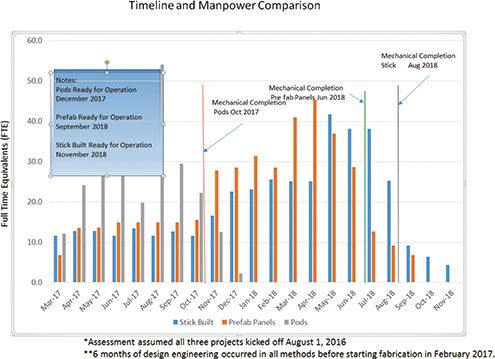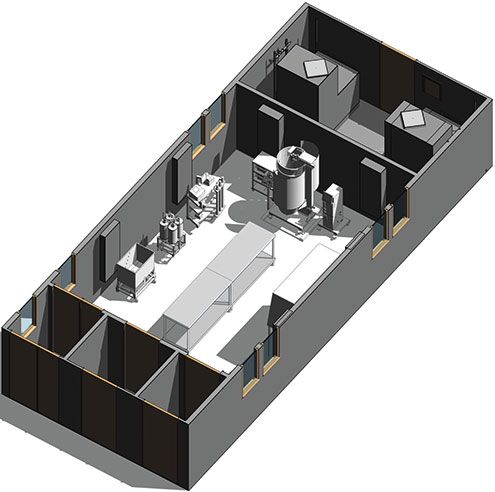Reducing Cleanroom Complexities and Cost
Why shouldn’t biopharmaceutical manufacturers be able to leverage standardized construction practices to improve time to market?
ESB PROFESSIONAL/SHUTTERSTOCK.COM

For pharmaceutical and biopharmaceutical manufacturers today, a key success factor is time to market (1–4). When it comes to processes and manufacturing facilities, time to the first product run is crucial. The faster a drug moves through the development pipeline and the faster a facility is up and running, the higher the return on investment. In addition, a fast-moving facilities project can allow capital expenditures to be delayed until later in the development cycle, minimizing risks and maximizing the amount of cash on hand until needed.
The traditional approach
Traditional facility designs and infrastructures do not permit such fast-track implementation (5). It takes months to generate designs and even longer to build these manufacturing sites, and construction proceeds sequentially.
The process generally follows this pattern: a building shell is built first, followed by utilities, then ancillary and cleanroom spaces, and finally production equipment is installed. Typically, this approach means a time-to-first-product run of 24–48 months, depending on the size of the facility. The same is true for smaller projects such as laboratories.
Modular options
Modular construction onsite involves building processing space at the ultimate production location using modular wall panels. Many companies provide such panels. This approach differs from traditional construction in that the panels are rigid and therefore do not require framing material. The panels also come in a variety of sizes, reducing the amount of cutting required onsite.
The panels also reduce the amount of finishing work that is required, because they are supplied as finished pieces such as coving at the wall-to-ceiling and wall-to-floor connection points. The use of standardized components can shorten the design phase for modular panel projects, compared with the time required by traditional approaches. Significant engineering knowhow is still required, however, to make modular construction work.
Because this approach reduces the amount of onsite construction required, these projects can be completed faster than a traditional construction approach, with project timelines that can range from 18 to 36 months depending on the size of the project.
Prefabricated cleanrooms
Prefabricated cleanrooms are modules that are built offsite that provide clean space including floors, walls, ceilings, windows, and doors in appropriate finishes. In some instances, such modules include their own mechanical space where automation equipment such as programmable logic controllers (PLCs), heating, vacuum and air conditioning (HVAC) equipment, fire suppression systems, utility connections, etc. are housed.
The cleanrooms are built entirely at a vendor’s manufacturing site. At the close of the manufacturing process, they are factory tested. After this testing, they are shipped and moved into the ultimate host facility. Due to the utility infrastructure within the cleanrooms, connections to the host facility are minimal, and infrastructure within the host facility is also minimal. High level advantages include being able to build the modules rapidly without the need for special permits, the lack of required infrastructure at the ultimate destination, the ability to move and repurpose the cleanrooms, and depreciating the cleanrooms on an accelerated basis as process equipment, as opposed to the traditional facility timeframe (6).
Engineering expertise is required both for the cleanroom and the outer structure. Compared with the fairly standard cleanroom approach in most cases, however, there is less to engineer using this approach.
A leading architecture and engineering firm considered the amount of time required to build a 2000L monoclonal antibody (mAb) facility. The study considered three types of facility options: traditional, modular wall panel, and prefabricated cleanrooms. Figure 1 presents findings.
Figure 1: Timelines for different types of plant construction project [all figures courtesy of the authors].

As can be seen in Figure 1, the time differences among the three models are substantial, with prefabricated systems being much faster. For one manufacturer, using the prefabricated approach allowed the facility to be ready for operation 16 months after the start date (1) compared with 25 months for the paneled approach and 27 months for the stick-built approach. Construction of the prefabricated system solution was faster due, in part, to the fact that the cleanrooms were built in parallel with the building or refurbishment of the host facility (Figure 2). Such an approach is not possible with the other construction options, because the structures must be constructed after the host facility is substantially complete.
Figure 2: A prefabricated cleanroom POD, containing controls and utilities.

An additional factor that also saves time, which this study did not consider, is the fact that prefabricated cleanrooms use standard designs. Instead of creating new designs from scratch, these standard designs can be used to reduce the design time and cost effort.
As noted, some standardization of cleanroom options can reduce the time required to build out a facility, using a prefabricated approach. But could standardization also lead to other advances as it has in other industries, enhancing speed to market without sacrificing quality or utility?
Procter and Gamble showcased an example of what might be possible for pharma at the International Society for Pharmaceutical Engineers’ (ISPE’s) 2014 Annual Meeting. The presentation discussed the use of standardized shell buildings that could be erected in weeks. Parallel to the construction of the building shell, prefabricated manufacturing modules were assembled and then added into the shell when it had been completed.
Mixing and matching, in synch with demand
The prefabricated manufacturing modules were standardized and could be mixed and matched into the shell building. Depending on demand, they could also be exchanged, in case regional demand for one product rose or fell. Standardizing the system created budget and timeline robustness, as well as scaling effects to reduce costs (7).
Another example comes from the automotive industry. In automobile manufacturing today, the core product is standardized, but also configurable, with options that are related to aesthetics or performance. Standardizing the core product keeps costs low and delivery times short, and adding options to that core does not increase either factor significantly.
If carmakers sought to design each vehicle anew, with no standard platform in place, costs would be astronomical and the efficiency of production and delivery would be exceedingly low. The question is: Can the biopharmaceutical industry mirror these two examples, especially in the cell and gene therapy space? Why shouldn’t it be possible to standardize these processes, unit operations, and surrounding cleanroom infrastructures all the way to the facility platform?
Standardization vs. status quo
Why has such standardization been achieved, or even become the norm, in other industries but not the biotech industry? Is it because the engineering or processing needs are that much more sophisticated than other industries, or is it because the supplier infrastructure in the biotech industry prefers self-preservation to innovation?
More to the point, couldn’t a prefabricated, standardized but configurable cleanroom infrastructure solution be provided much like a car, bioreactor, or filler? Shouldn’t such infrastructures be available from a catalogue where they can be chosen for delivery? And is there any reason why that cleanroom couldn’t be delivered in 48 hours?
Amazon and FedEx deliver hundreds of thousands of items in two days. Mobile homes can be ordered. Contractors build and sell “spec” houses every day. So why can’t biotech companies choose from available options instead of re-inventing the wheel every time they have to build a new manufacturing facility?
The goal for the industry should be to configure a cleanroom on-line or at a showroom and get it delivered consistently with the same quality at a fixed price and timeline. End-users who adopt this standardization approach will gain desired speed, with tremendous flexibility and greatly reduced costs. That can only be good for the industry and, ultimately, for the patients it serves.
References
1. H.L. Levine, et al., “Efficient, Flexible Facilities for the 21st Century,” BioprocessInternational.com, 2012.
2. J. Markarian, “Continuous Solid-Dosage Manufacturing Platform Nears Prototype Installation,” Pharmtech.com, November 2, 2014.
3. P. Thomas, pharmamanufacturing.com, January 10, 2012, www.pharmamanufacturing.com/articles/2012/008/.
4. A. Pralong”Biopharma Asia Magazine, 2 (1), pp.12-14 (2013).
5. P. Almhem, “Modular/Flexible Facilities,” Pharmaceutical Processing, July/August, pp. 28-30 (2014).
6. M.W. Jornitz, “Podified Manufacturing Facilities and Risk Mitigation of Aging Pharmaceutical Facilities,” April 2014, pharmaceuticalonline.com.
7. Press Release, pharmaceuticalonline.com, September 27, 2013.
Article Details
Pharmaceutical Technology
Supplement: Outsourcing Resources
Vol. 42
August 2018
Pages: s26–s28
Citation
When referring to this article, please cite it as S. Backstrom and M. Jornitz, " Reducing Cleanroom Complexities and Cost," Pharmaceutical Technology Outsourcing Resources Supplement (August 2018).
About the Authors
Sidney Backstrom is vice president of business development (sbackstrom@gconbio.com), and Maik Jornitz is president and CEO, G-CON Manufacturing, Inc.

Drug Solutions Podcast: A Closer Look at mRNA in Oncology and Vaccines
April 30th 2024In this episode fo the Drug Solutions Podcast, etherna’s vice-president of Technology and Innovation, Stefaan De Koker, discusses the merits and challenges of using mRNA as the foundation for therapeutics in oncology as well as for vaccines.